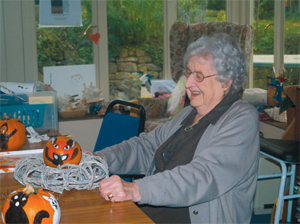Amabel Mortimer reveals how art therapy supports people living with life-threatening conditions.

Launched in 2004, Sue Ryder Care’s annual ‘Art Liberating Lives’ art event has to become the healthcare charity’s flagship fundraising campaign. It celebrates the importance of art as a form of therapy, expression and liberation – and is an important platform for us to showcase the works of art created by the people we care for. Now in its fifth year, Art Liberating Lives is a nationwide art competition that asks professional, amateur, celebrity and young artists to create artwork on the theme of ‘liberation’. A judging panel selects the best artworks, which are then displayed at the Mall Galleries in London. The artworks submitted works sit alongside those produced by people cared for by Sue Ryder Care. Money raised from the sale of artworks help us continue to deliver care nationwide.
The 2008 exhibition was incredibly emotive. As well as showcasing how art can liberate the people we care for, it was clear to see that art is a powerful medium for our supporters to express their emotions too. Throughout our six hospices and eight neurological care centres we run one-to-one and group art sessions, which thousands of people in our care get involved in each year. Art really is a form of liberation allowing people to explore thoughts and feelings that their illnesses might otherwise make difficult to convey. My role at a Sue Ryder Care Hospice in Cheltenham involves providing patients with a suitable and exciting range of art, craft and diversional activities tailored to their needs. We continually look for new arts and crafts, as well as running sessions such as monoprinting, beading and painting. We have also made memory books and boxes with patients which are hugely important projects for all involved.
Art and craft activities often provide a welcome diversion from the day-to-day difficulties of living with an illness that requires palliative and neurological care. Despite being within a medical setting, the art room is a vibrant place, full of life and laughter. It is a place where patients find friendships and support along with the enjoyment and pride of creating something. There is a lot of evidence to support art as a diversional therapy and I see the results of this on a daily basis. It’s great to watch people’s confidence grow, and I have been told that attending an art class is the highlight of some people’s week. Patients retain control over when and how they do things and, for some, art offers an opportunity to rediscover or reaffirm who they are. Having a medical diagnosis means appropriate treatment can be identified, but with that also comes the medicalisation of the self – some people may no longer feel like themselves and what they knew prior to diagnosis may be shattered. Reaffirming the self is an important journey some patients will take and I firmly believe that providing art as a form of therapy is a crucial step in that journey.
Amabel Mortimer is Creative and Diversional Therapies Co-ordinator at Sue Ryder Care’s Leckhampton Court Hospice in Cheltenham. Sue Ryder Care’s Art Liberating Lives 2009 is launched in April.
e: ruth.peters@suerydercare.org
w: http://www.suerydercare.org



